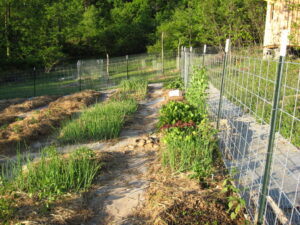A version of this column first ran in the Roane County (WV) Reporter and Times Record. Support local journalism! Subscribe to your local newspaper.
 Late April—time to set out plants, plant seeds, plant potato sets…but first, we need to talk more about soil preparation. In the first column, I mentioned getting your soil tested, but it can take weeks to get your analysis back, especially in the busiest time—now. Meanwhile, there are some quick and (literally) dirty ways to test your soil.
Late April—time to set out plants, plant seeds, plant potato sets…but first, we need to talk more about soil preparation. In the first column, I mentioned getting your soil tested, but it can take weeks to get your analysis back, especially in the busiest time—now. Meanwhile, there are some quick and (literally) dirty ways to test your soil.
Squeeze a handful of moist soil. Does it maintain shape, even showing the imprint of your fingers? You’ve got clay soil. Does it crumble away? You’ve got sand. Does it form an easily crumbled ball resembling chocolate cake? You’ve got an ideal loam soil. Dark brown soil is rich soil.
Another test: fill a quart jar half full of soil, then fill with water and shake thoroughly. Let sit 24 hours. The sand will settle on the bottom, then silt, with the fine clay particles on top. Ideal soil has 20% clay, and 40% of each of the others.
The pH of your soil is how acidic or alkaline it is. Most garden plants want neutral or slightly acidic soil. Soil that is too alkaline can be corrected with sulfur, which can be bought by the pound and sprinkled on the surface. Acidic soil (most common here) can be sweetened with lime or wood ashes.
So what if your soil is not ideal? Fortunately, improving your soil is less confusing than testing it: basically you want to add organic matter. That will correct both sandy soil, so it will retain moisture and nutrients, and clay soil, making it more loose and open. If you have compost, work lots of it into the top few inches of your garden. If not, use manure if you can find some. Goat, alpaca, sheep and rabbit manure can all be used while still fairly fresh. Horse, cow and chicken manure should be composted for six months before use. Usually there is lots of bedding mixed in, which is fine. It’s hard to use too much compost, but if you add manure every year you could wind up with an imbalance.
As a last resort, you can buy bags of composted manure; these are usually mostly peat moss, which is acidic and lacks nutrients, but it does add organic matter.
Another thing to do now if you haven’t already is to start a compost pile. There are whole books on this, and if you properly layer the “greens” and “browns” and turn it frequently you can have compost sooner… but if you just pile up all your kitchen scraps, weeds, old mulch, manure (but not from cats or dogs) and leaves, you will get compost. It’ll just take a little longer. A pile you start now will be great for revamping beds in late summer or fall; you won’t likely be able to use it sooner.
I am an organic gardener and don’t use fertilizer, but if you choose to, get advice from your local WVU extension agent. Consult them also about soil tests and other matters.
There are ways to start a garden without tilling, but this requires a huge amount of organic matter, so I’m going to assume you’ve tilled in your compost and corrected the pH. Now what? Next is putting up a fence—more on that next week. What can you plant?
If you haven’t already, it’s time to plant peas, onion sets, lettuce, spinach and radishes. You can plant carrots and beets now too, and Swiss chard (I favor the Bright Lights strain, which is several beautiful colors—some people plant this as an ornamental).
It’s also time to plant potatoes. It will not be too late to plant most of these for another month, but the spinach and peas need to get in the soil now. It’s also now not too early to set out your brassica plants: broccoli, cabbage, kale, cauliflower, Brussels sprouts and bok choy. These want rich soil and may do well with a little shade by the end of their season (they don’t like summer heat).
To reduce weeding, maintain moisture, and add organic matter, mulch is a good idea for just about every crop. Typically it’s composed of hay or straw. You can put down a double layer of newspaper under the hay to make it more effective—but the paper alone won’t work as it will blow away. Cardboard can also work; I use it along the fenceline.
Note that mulch should not be pulled right up against plant stems; it may cause excess heating and rot. This mulch will eventually add organic matter to your soil but don’t allow it to remain on the ground through winter, as it may harbor pests or diseases. Instead, add it to your compost pile.
Use the comment section for questions, objections and suggestions.
